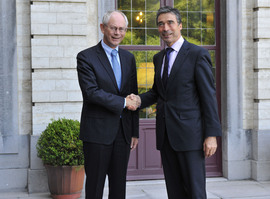NATO’s new Strategic Concept, adopted at Lisbon, commits the Alliance to prevent crises, manage conflicts and stabilize post-conflict situations, including by working more closely with NATO’s international partners, most importantly the United Nations and the European Union.
The Strategic Concept clearly states that an active and effective European Union contributes to the overall security of the Euro-Atlantic area. Therefore the EU is a unique and essential partner for NATO. The two organizations share a majority of members (21), and all members of both organizations share common values.
NATO recognizes the importance of a stronger and more capable European defence. The Allies welcome the entry into force of the European Union’s Lisbon Treaty, which provides a framework for strengthening the EU’s capacities to address common security challenges. Non-EU European Allies make a significant contribution to these efforts. For the strategic partnership between NATO and the EU, their fullest involvement in these efforts is essential.
NATO and the EU can and should play complementary and mutually reinforcing roles in supporting international peace and security. The Allies are determined to make their contribution to create more favourable circumstances through which they will:
- fully strengthen the strategic partnership with the EU, in the spirit of full mutual openness, transparency, complementarity and respect for the autonomy and institutional integrity of both organizations;
- enhance practical cooperation in operations throughout the crisis spectrum, from coordinated planning to mutual support in the field;
- broaden political consultations to include all issues of common concern, in order to share assessments and perspectives;
- cooperate more fully in capability development, to minimise duplication and maximise cost-effectiveness.
Close cooperation between NATO and the European Union is an important element in the development of an international “Comprehensive Approach” to crisis management and operations, which requires the effective application of both military and civilian means.
Institutionalized relations between NATO and the European Union were launched in 2001, building on steps taken during the 1990s to promote greater European responsibility in defence matters (NATO-WEU cooperation¹). The political principles underlying the relationship were set out in the December 2002 NATO-EU Declaration on ESDP.
With the enlargement of both organizations in 2004 followed by the accession of Bulgaria and Romania to the European Union in 2007, NATO and the European Union now have 21 member countries in common².
2. 28 NATO member countries: Albania, Belgium, Bulgaria, Canada, Croatia, Czech Republic, Denmark, Estonia, France, Germany, Greece, Hungary, Iceland, Italy, Latvia, Lithuania, Luxembourg, the Netherlands, Norway, Poland, Portugal, Romania, Slovakia, Slovenia, Spain, Turkey, United Kingdom, United States.
27 EU member countries: Austria, Belgium, Bulgaria, Cyprus, Czech Republic, Denmark, Estonia, Finland, France, Germany, Greece, Hungary, Ireland, Italy, Latvia, Lithuania, Luxembourg, Malta, the Netherlands, Poland, Portugal, Romania, Slovakia, Slovenia, Spain, Sweden, the United Kingdom.

